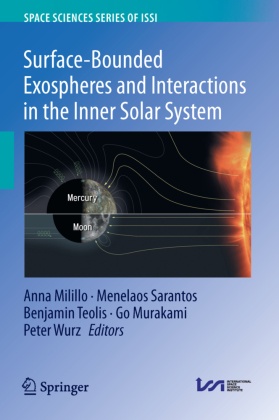Surface-Bounded Exospheres and Interactions in the Inner Solar System
| Verlag | Springer Netherlands |
| Auflage | 2024 |
| Seiten | 417 |
| Format | 16,0 x 2,5 x 24,2 cm |
| Gewicht | 827 g |
| Artikeltyp | Englisches Buch |
| Reihe | Space Sciences Series of ISSI 84 |
| EAN | 9789402422917 |
| Bestell-Nr | 40242291DA |
Studying the evolution of the surfaces and atmospheres of planetary bodies in the solar system is fundamental to our understanding of the present state of the solar system. Exospheres are the interfaces between the planetary body and the open space, so that, studying the exospheric filling and loss processes is the way to expand knowledge of the body's evolution. Surface and atmospheric changes are caused predominantly by the continuous bombardment of the bodies by photons, energetic ions, and micrometeoroids. Eventually, the ongoing processes are functions of the space environment, in other words, the planets are subjected to space weather.
This book focuses on the large subset of planetary objects (planets, moons, and small bodies) that are not protected by either strong magnetic fields or thick atmospheres in the inner solar system where the solar influence is stronger. The main exponents class regarding this class of objects are Mercury and the Moon. In these cases, the exosphere is directly connected to the surface, thus, it is called a surface-bounded exosphere. This is due to the surface release processes that are also the exospheric filling ones, where atoms and molecules collide with the surface far more frequently than collisions with each other.
During the last decade, several space missions provided important new findings for many airless bodies. Furthermore, new ground-based imaging techniques offered the possibility of improved exosphere observations. In the next decade, the ESA-JAXA BepiColombo mission will explore Mercury utilizing two spacecraft. And on a global scale, almost all space agencies will foresee orbiters and landers to the Moon as part of their space programs.
This collection of articles summarizes the current state of knowledge on surface-bounded exospheres, as a support for the interpretation of data that will be received from the forthcoming missions, for the next-generation of scientists that will b e involved in the exploration of Mercury, the Moon and other airless bodies, including exoplanets.
Reprinted from the Space Science Reviews Topical Collection Surface-Bounded Exospheres and Interactions in the Inner Solar System
Inhaltsverzeichnis:
Editorial to "Surface-Bounded Exospheres and Interactions in the Inner Solar System".- Particles and photons as drivers: Comparison between Moon and Mercury.- Surface Exospheric Interactions.- Meteoroids as one of the sources for exosphere formation on airless bodies in the inner solar system.- Volatiles and refractories in surface-bounded exospheres in the inner Solar System.- Comparative Na and K Mercury and Moon exospheres.- Water Group Exospheres and Surface Interactions on the Moon, Mercury, and Ceres.- The Exosphere as a Boundary: Origin and Evolution of Airless Bodies in the Inner Solar System and Beyond Including Planets with Silicate Atmospheres.- Future directions for the investigation of surface-bounded exospheres in the inner Solar.

